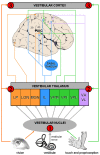A neuroscientific account of how vestibular disorders impair bodily self-consciousness
- PMID: 24367303
- PMCID: PMC3853866
- DOI: 10.3389/fnint.2013.00091
A neuroscientific account of how vestibular disorders impair bodily self-consciousness
Abstract
The consequences of vestibular disorders on balance, oculomotor control, and self-motion perception have been extensively described in humans and animals. More recently, vestibular disorders have been related to cognitive deficits in spatial navigation and memory tasks. Less frequently, abnormal bodily perceptions have been described in patients with vestibular disorders. Altered forms of bodily self-consciousness include distorted body image and body schema, disembodied self-location (out-of-body experience), altered sense of agency, as well as more complex experiences of dissociation and detachment from the self (depersonalization). In this article, I suggest that vestibular disorders create sensory conflict or mismatch in multisensory brain regions, producing perceptual incoherence and abnormal body and self perceptions. This hypothesis is based on recent functional mapping of the human vestibular cortex, showing vestibular projections to the primary and secondary somatosensory cortex and in several multisensory areas found to be crucial for bodily self-consciousness.
Keywords: bodily consciousness; body image; body schema; caloric vestibular stimulation; multisensory integration; touch; vestibular system.
Figures

Similar articles
-
The vestibular system: a spatial reference for bodily self-consciousness.Front Integr Neurosci. 2014 Apr 17;8:31. doi: 10.3389/fnint.2014.00031. eCollection 2014. Front Integr Neurosci. 2014. PMID: 24860446 Free PMC article. Review.
-
Making Sense of the Body: the Role of Vestibular Signals.Multisens Res. 2015;28(5-6):525-57. doi: 10.1163/22134808-00002490. Multisens Res. 2015. PMID: 26595955 Review.
-
Distinct illusory own-body perceptions caused by damage to posterior insula and extrastriate cortex.Brain. 2013 Mar;136(Pt 3):790-803. doi: 10.1093/brain/aws364. Epub 2013 Feb 18. Brain. 2013. PMID: 23423672
-
Out-of-body experience in vestibular disorders - A prospective study of 210 patients with dizziness.Cortex. 2018 Jul;104:193-206. doi: 10.1016/j.cortex.2017.05.026. Epub 2017 Jun 8. Cortex. 2018. PMID: 28669509
-
Unconscious integration of multisensory bodily inputs in the peripersonal space shapes bodily self-consciousness.Cognition. 2017 Sep;166:174-183. doi: 10.1016/j.cognition.2017.05.028. Epub 2017 Jun 1. Cognition. 2017. PMID: 28577447
Cited by
-
Editorial: The Vestibular System in Cognitive and Memory Processes in Mammalians.Front Integr Neurosci. 2015 Nov 10;9:55. doi: 10.3389/fnint.2015.00055. eCollection 2015. Front Integr Neurosci. 2015. PMID: 26617498 Free PMC article. No abstract available.
-
Anchoring the Self to the Body in Bilateral Vestibular Failure.PLoS One. 2017 Jan 20;12(1):e0170488. doi: 10.1371/journal.pone.0170488. eCollection 2017. PLoS One. 2017. PMID: 28107424 Free PMC article.
-
Interaction between Vestibular Compensation Mechanisms and Vestibular Rehabilitation Therapy: 10 Recommendations for Optimal Functional Recovery.Front Neurol. 2015 Jan 6;5:285. doi: 10.3389/fneur.2014.00285. eCollection 2014. Front Neurol. 2015. PMID: 25610424 Free PMC article. Review.
-
Could Brain-Computer Interface Be a New Therapeutic Approach for Body Integrity Dysphoria?Front Hum Neurosci. 2021 Aug 11;15:699830. doi: 10.3389/fnhum.2021.699830. eCollection 2021. Front Hum Neurosci. 2021. PMID: 34456696 Free PMC article. Review.
-
Vestibular prosthesis: from basic research to clinics.Front Integr Neurosci. 2023 May 16;17:1161860. doi: 10.3389/fnint.2023.1161860. eCollection 2023. Front Integr Neurosci. 2023. PMID: 37265514 Free PMC article. Review.
References
-
- André J. M., Martinet N., Paysant J., Beis J. M., Le Chapelain L. (2001). Temporary phantom limbs evoked by vestibular caloric stimulation in amputees. Neuropsychiatry Neuropsychol. Behav. Neurol. 14 190–196 - PubMed
LinkOut - more resources
Full Text Sources
Other Literature Sources

